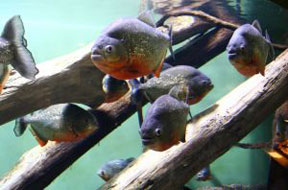Alerts
Please be advised that our bird aviaries are open!
Your Toronto Zoo is committed to the health and safety of the animals in our care. We take proactive steps to protect our birds from Avian Influenza which has been confirmed in a wild bird in southern Ontario, and some birds may still be off display.
Please note Splash Island is still closed and will not open until July due to unforeseen delays in construction. Please watch for updates on https://www.torontozoo.com/tz/splash or on our social media pages. Thank you!
Please note the following animals are currently not on display due to various reasons including Avian Bird Flu, and Covid-19 sensitivity:
- Flamingo, peacock, owl, bald eagle, and aviaries
- Some Kids Zoo Animals
- Cougar
- Moose
- Kangaroo walk through (kangaroos are still visible)
- Axolotl
We apologize for the inconvenience!


Fish
Location at the Zoo:
Americas
Region: South America
Red-breasted piranha
Size is usually 15 to 25 cm long although some specimens have been reported to be up to 43 cm in length. Piranhas are generally flattened from side to side and have a high body; all have an adipose fin. All piranhas have a single row of sharp teeth in both jaws; the teeth are tightly packed and interlocking and are used for rapid puncture and shearing. Individual teeth are typically broadly triangular, pointed, and blade-like.The sides are olive green to pale brown, in some individuals marked with darker blotches in no particular pattern. Some scales on the sides sparkle in certain light conditions and reflect bright silver or yellow. The back is dark blue-grey or brown. The throat, belly, as well as pectoral, pelvic, and anal fins are bright red in healthy specimens.
Conservation Status: IUCN
